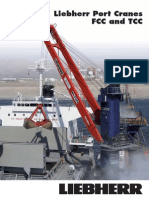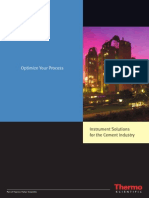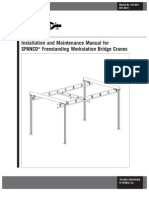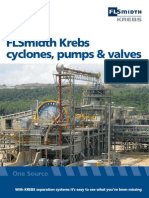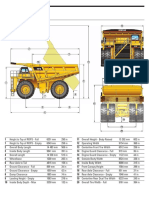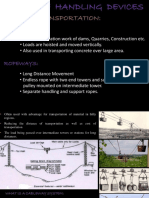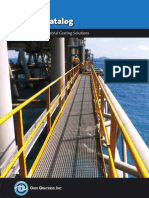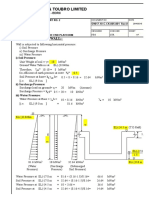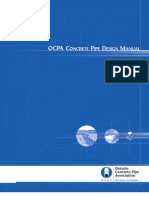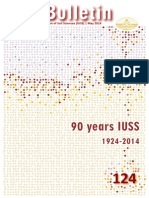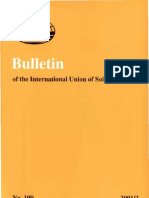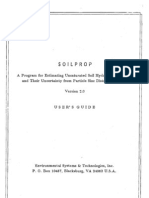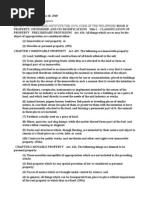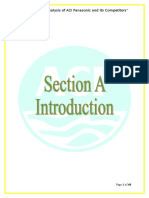Ross E. Moore, WATER CONDUCTION FROM SHALLOW WATER TABLES
Ross E. Moore, WATER CONDUCTION FROM SHALLOW WATER TABLES
Uploaded by
Scary CreaturesCopyright:
Available Formats
Ross E. Moore, WATER CONDUCTION FROM SHALLOW WATER TABLES
Ross E. Moore, WATER CONDUCTION FROM SHALLOW WATER TABLES
Uploaded by
Scary CreaturesOriginal Title
Copyright
Available Formats
Share this document
Did you find this document useful?
Is this content inappropriate?
Copyright:
Available Formats
Ross E. Moore, WATER CONDUCTION FROM SHALLOW WATER TABLES
Ross E. Moore, WATER CONDUCTION FROM SHALLOW WATER TABLES
Uploaded by
Scary CreaturesCopyright:
Available Formats
,-
!
H I L G A R D
A Journal of Agricultural Science Published by
the Caliform'a Agricultural E:rperimr:nt Station
I
VOL. 12 :MAROH, 1939
WATER OONDUOTION FROM SHALLOW
WATER TABLES'"
ROSS E.
INTRODUOTION
A
No.6
THE PFIENOlrESON of the flow of liquids through porons medhmls with-
out the applicatioll of external force and without complete filling of the
pores of the soliel with liquid, has IOllg been recognized and studied. It
was en.l'Iy recognized thnt the forces it{"olved arc those of adhesion and
cohesion, the same as those responsible for the nction of liquids in capil-
lary tubes. The term "capillarity" (6, 17) I has thus COIlle to apply to the
flow of liquids through porons mediums.
l\fanyanalY:ies (28-31) have been made for the purpose of evaluating
the capillary forces acting ill systems, such as is the ease in
moist soil, consisting of solid, liquid, and gas) by assuming spherical solid
purticles of uniform size and sequence of packing arrangement. While
this nssmnption has prcsented concepts of value in comprehending the
mechanism involved in capillary flow, the size und confignration of the
solid anc1liquid phases are very complex in even the most idealized
terns, und become indeterminate when applied to natural bodies such as
soil.
The capillary potential concept, introduced by Bucldngham (6) in
1907, ussumed a capillary force field generated by the attraction of moist
soil for water. He defined a capillary potential, the gradient of which is
equnl in magnitude to the capillary force. The introduction of the poten-
tial function gave rise to the study of soil-moisture as a dynamic system;
but this method received no added impetus until 1922, when Gardner (9)
and others showed that the capillary potential of Buckingham mny be
1 Recei ....ed for publicntion June 8, 1938.
Abridged from n. thesis submitted in partial .fulfillment of the requirements for
the degree of doctor of pliilosophy.
n Instructor in Soil Technology and Junior Soil Technologist in the Experiment
Station.
'Itnlic figures in parentheses refer to ULiternture Cited" nt end of this pnper.
[ 383 1
HHgarl1ia [VOL. 12, No.6'
considered us" a pressure potential the differential_press1;lres on
either side of the liqui(1-gns interface in the menisci of the water films.
They further showed it to be directly measurable, oyer a certain range of
potential, by measuring the negative hydrostatic pressures within the
water 1ms of soil moisture. The instrument used for these 9-irect meas-
urements wns called n capillary potentiometer, but is now eaUed a tensi-
ometcr (19) I Hnd cunshits of n porons absorbing element, all adaptation
of the IJiviligstoll Auto Irrigatol', to which a manometer is attached.
WhelL the cnpillary potentiometer was filled with water uncl the porous
absorbing' clcment wus embedded in the moist soil whose capillary poten-
tiul was to be measurcd, wuter trunsfer took place between the porous
element and the soil until, at equilibriuIll, the pressure of the water inside
the potentiometer wus equal to the pressure in the snil-moisture lms,
This pressure WLlS read directly on the manometer.
In the application of the dynumic concept to soil moisture studies, the
velocity of flow or water through the soil is considered to be proportional
to the totnl water-moving force. A conductivity factor, variously called
capillary conductivity, capillary trnnsmission constant, couductivity,
and permeability, has been used to express this proportionality (3,7,8,
10
J
16). 'rhe tel'Ill Hpermeability" is adopted in this paper.
Many data on the permeability of soils in saturated flow or, with the
pore entirely filled with wnter, nre uvuilable in of the
U. S. Geological Survey, the American Geophysical Uliion, filul in en-
gineering papcrs, Slichter (21) made theoretical calculations for the
flow of underground watcr under pressure, in which it WIIS nssumed
that the vclocity of flow was proportiollul to the preSS11re g'l'lldient. 'rhcre
It!'c rclnth'ely few published data on soil permeability in unsaturated
flow, however. Such dutn as have been reported were derived from ex-
periIneutalresults on relntiYely small quantities of soil through ,yhich
flow was induced by urtificiully maintaiuing uitierential pressures ill the
l110isture films on either' side of the smnple. Richards (17,18,20) hus pub-
lished datu. on three soils, including capillary potential us a function of
wllter content, pcrmeability us a function of water content und capillary
potential, and permeability of a peat soil as u function of capillary
potential.
'rhe evuluation of the movement of water' through lUlsaturated soil
is important in many practical problems, snch as: the (1rainage of lund,
of road subgrudes, and of all structural foundations and puyements laid
on the ground j the contribution of It water table to the water supply of
plnnts j the loss of water from a soil surface by evaporation j and the
upward translocation and concenh'ation of soluble salts in the soil.
March, 1939]
Moore: Water Conc111ction from ShallolU Watcr TllllIes
385
This paper reports pressure potential and saturated and unsaturated
permeability datu, using six California soils. The rate of water flow 1'e-
:0 shallow water tables in cylindrical soil eolumns B
Inches lU dIameter, was measured in graduated supply burettes. Un-
saturated flo,Y was induced naturally j the water rose from the water
table to the stu'face of the soil columns br capillarity, and was evaporated
the smface. TensiometeI's were spaced at regular intervals on the
axis of the soil columns, and the pressure potential values were
read dll'ectly all these instruments. When the rate of water uptake and
the pressure potentials throughout n soil column became steady thnt
column. was said to be at steady state. Its moisture distribution tllen
by sampling, and its saturated and unsaturated permenbili-
tIes at varlOUS pressure potentials were determined from the velocity of
flow and the total potential gradient. .
PROOEDURE
moisture studies reported herein were carried out ill a room in a
hgllt frame building of tho University of California at Berkelev. The
ro.om was 8 x 16 feet, and 12 feet high, "'HIt a reinforced floor
Imd on ground, The wnl1s were of tongue-und-grooye pine sheathing
on 2 x 4: lneh studs spaced at 2-foot centers, the naked studs beinO' on
the room side. After beginning this experiment the walls and eemnfl"
were lined with celotex lyuUboard which Was to the studs. I:>
The room was heatec! by two batteries of electrical hentinO' elements
one battery placec1 at either enc! of the room alJOut 4 feet fr;m the en(l
walls 6 feet from the floor. Hent distribution wns effected by foul'
electrIC fans, so placec! us to give maximum nil' turbulence as well as
general air circulation to all purts of the room,
.'rhe heating elements had two circuits, one continuous and aIle
nnttent. 'rbe intermittent circuit was opened anel closed by a thermal
regulator through a reI ny, 'remperature nt the thermal regulator was set
at 30 C, and controlled to about 0.02. Temperature along the sides
of the room and Bear the fioor could not be held to this narrow range
due to heat loss tlll'ough the I'ather poor'ly insulated walls. The soil
columns, which were set in a l'OW close to a walI, normally held to a
!emperature of 0.02 C, e:\':cept (!tu'ing periods of abnormal change
ln the atmospherle temperature outside the room.
Six soils were used, ranging in texture from slmd to clay (table 1). All
except one, the Oakley sund, were of the Yolo series. 'l'be nirchy soils
were prepared for filling the cnns by breaking them down to pass a a-mm
sereen.
386
Hilnardia
[VOL. 12, No, 6
The soil cnus were of galvanized iron, cylindrical, 8 inches in diameter
and 3 to 4 feet high (fig. 1), and were fitted with a wirescreen dia-
phragm soldered 2 inches above their bases to provide support f01: the
soil columns. A water inlet tUbe,.%, inch in diameter, was soldered 1 moh
above the bottom of each can. Each can was pnnched with %.i:,ch holes
in foul' vertical rows, oue row at each quarter point on the can's
ference. The vertical distance between holes in the row and tIle elevatIon
of each row, were arrnnged to give a hole for each inch of can height.
Before a can was filled ,,1th soil the holes were closed with patches of
TABLE 1
ANALYSIS AND MOISTURE EQUIVALENTS DE' TilE SOILS USED
OuldllY Yolo Yolo fin!;! Yolo Yolo Yolo
Sopnrotcs
I!llnd BUild allndl'lonm dlll'lollm light c1lll' clul'
Fine grnvlll.. ...............
0,2 2.11 0.1 0.1
Conrail Hnnd ............... D.O 16.4 0.3 0.5 0.1 0.2
-r;redhnn :lund ..... lli.3 25.8 0.5 0.11 0.4 0.3
.............. ..
45.1 41.8 lS.1I 5.3 7.2 3.0
Very .............. 2004 0.0 31.0 21.0 16.1 S.1
TotnlslLnd .............. 110.11 02.11 5[1.8 27.1i 23.S 11,6
Totul Hilt (by difference) .... 3.' 3.3 31.5 46.0 45.0 4n.5
Totnlclnl' ........... 5.0 3.B 17.7 2n.5 31.2 41.0
Clnl'<2 micron ............. '.D
3.2 12.8 17.2 23.2 33.1
Clny<l micron ............. '.0
2.0 D.'
J3.5 17.4 20,5
i\foistllrll cquivnlllllt. ....... '.3
3.5 IB.l 22.5 25,D 2n.3
celluloid cemented to the outside. When the wetting front in the soil
column reaclled a hole, the celluloid patch was removed, the soil sampled
for moisture coutent, and the hole reclosecl with n rubber stopper.
The procednre ill filling the can with soil wus similar to the tt'emie
method for placing concrete uuder water (36). A strong' fiber tube, 4
inches ill outside cliameter, nuc14 feet long, originally made for the pack-
inn' and shipment of glnss tubing, was used as a tIemie.
The tremie tube, surmounted by a funnel, was placed upright in the
soil can. One.man kept the funnel and tr'emie full of soil and a second
man operated the treIllie, partly supported its weight, kept it "ertical,
and moved it with a rotary motion so the tube described n circle, the
(liameter or which was equal to the diameter of the soil can. The bottom
of t11e tube, resting lightly on the soil, pnssecl over the entire area of the
soil column at each revolution, and t.hus maintained a level and regular
surface. Approximately eight revolntions of the tremie were per
inch of depth of soil eolllmnlaid down.
The entire system, cau, tremie, and soil, was weighed at 0.
approximatelY 4 inches in the soil-column height. For the height of SOlI
Mnrch,1039] Moorc: Watcr Conduction from SlwllolU Watcr Tablcs 387
at each 4-inch stage tllC mean of eight to ten measurements was taken j
these measurements were made from the top of the can with a meter stick
which was dropped vertically onto the soil through a distance of ap-
Fig. I.-Soil cuns with tensiometers installed.
.A, Cnn with lllel'emy tensiometers, showing the method of nttnching the
llLUlltIlilcter plinelulld the inHhlllutieu of the hmsiolllCtcrs, The instrument nt the
top of the pllliel .lli n yibrutur. 'rhc lowest tensiometer hns been relllo,ed from
the soil to show the CIIIl (flbsorbing element).
11, Cun with wnter teltsiol1leters instuJled. Eight tensiometers with wflter
nUlUcuueters flre lIl0tllltec1 all the left panel. The teusiometers enter t.he soil col
nom bnck of the panel. '1'wo open water manometers used for posith'e poteutinls
only nrc lllollnterl on the smull puuel at the right.
0, Assemhly of the tensiometer with It mercury manometer. 'rIds assembly wns
used for testing tensiometer cups amI is the snme us tho tensiometers installed in
the soil columns except that the stopeoclc, 3, wus replaced by n. screk clamp.
Details urc fiS follows: 1
J
A three-wn.y stopcock senled to n mule standar(l taper
ground gluss conner-tion. '1'he two rubber tubing lilies Bupply "ncuUlU nnd water
Itt atmospheric pressure. 8, Femnle standard tuper ground ginas connection.
3, TWO-Wily stopcock. 4, Porolls tiredcluy tensiometer cup. 5, Screw clump. 6,
Capillury stuff of mercm)' mUllometer.
proximately 1 inch. The net weight of soil in the CRn was later corrected
for air-dry water content.
Too few weighings were made on an individual soil column to allow
a statistical calculation of variation in apparent density for a single
column. A mean apparent density was calculated for each coluinn, and
3BB'
Hilgardia
[VOL, 12, No, 6
the densities for each stage of filling' were expressed as percentages of
that mean. These percentages were collected for all the soil columns, an-
nlyzed statisticnlly, nucl a single standard deyiation was calculated and
eA"}Jl'cssed "as per cent variation from the menn apparent density, This
single value was assumed to represent tlte standard deyiation in apparent
density for aU the soil columns (tuble 2). .
Wnter at constant pressure was sllpplie(l to the base of the columns
by water supply units (fig. 2), curried upward through the soil by capil-
TABLE 2
CRA.n.ACTERISTICS OF' TffE SOIL COLUl\1NS
Percent
Stund- Stnud- wllter
Lllilgth
nrd IIrd do-
"'
or I!oil I!ection, Welling Drying tlm'ill- vintion Percent autum-
Soil type nml CUll numbcr COIUIIIII, Slluo.ro timo, timc,
nppnr-
tlon of melU) porc tion hy
Cllt
centi- centi- dill'S dny!!
deliliity
of D.P- D.ppllr- spncl! weight.
mcters meters
eo'
OVCII-
density dn'
blwiH
------
------------
------
Onkley sund. 3 ...... 117 314 312 II lA8 0.042 0.00-1 4:1.3 211.2
Yolo liD.nd. 13........... 54 322 lOS
,
1.411 .042 .005 43.0 28.S
Yo'o .""""dy { 1 o' 117
31'
2811 72 1.25 .OJ!! .004 51.0 :m.1I
loo.m .......... 17 . 8! 322
"
7 1.:14 .035 .00-1 52.5 42.3
20 . B! 323 O! o' 1.25 .03,1 .00'
52.1 41.11
Yolo dny 1011111 {l!o"
S! 321 DB H 1.34 .0:lS .004 4!1.11 :1lI.2
III ..... 54 322 25 3 1.28 .0JIl .1104 51.0 30.S .
r
o' , 117
31'
'10
"
1.32 .1137 .004 411.5 37.1i
YlIllllight ClllY .. I;::. B! 320 25 1.211 .0311 .1104 50.5 :m.l
20 .. , o' S! 323
"
,
1.27 .0311 .004 51.3 4004
Yolu dlLl' ..... {lfi.
8! 322 BII 1:1 1.28 .!l3ft .004 51.0 :19.8
10.... ',1 312 37 o' 1.22 0.034 0.004 53.2 43.5
llll'ity, all{ll'emovec1 from the !mil surfacc by evaporation. 'rIte rule at
which water WHH tflkcn up by the soil measllred in thc graduated
supply burettes of the watcr supply units, and tlie upwHrd advance of
the wetted front 1,\'as observed through tlle celluloid-covered holes in the
sides of the cans.
'fensiometers (19), cOllshltillg of porous firctI clay absorbing elements
conuected to 'Vacuum gauges of the lllullometer type, were placed in the
soil columns one above the otller at intervals of 10 centimeters (fig. 1).
A transfer of water takes place between the soil and the absorbing ele-
ment until, at equilibrium, the pressure of the water iu the absc\;:bing
element is eqnal to that ill the moistme films of the soil. This presshre is
calculated from the height of mercury or other manometer liquid used
in the vacuum gauge.
Mnrch, 1030]
Mo()re: WaleI' COIull1clion /l'Om Shallow WaleI' Tablc8
aBO
400 l VOL. l<!J .No.6
4. t = 48 hours to t = 67 hours.
A .:).T / at = 0.032 0 per hour.
D. Slight decrease in pressure potentials.
c. Great increase in rate of water uptake.
5. t = 67 hours to t = 76 hours.
A .:).T/at=+ 0.23 o per hour.
D. Increase in pressure potentials of 2 gm-em/gm at 81 em above
the base of the soil column
J
and increasing progressively to more
than 10 gm-cm/gm at the water table. Water flowed downward
tlD:ough the soil and out of the cnu via the supply line. Greater
potentials would have been registered if water had not been lost
from the systcm.
c. '1.'he rate of water uptake became negative. '1.'he negative absol'p-.
tiOll rates shown all the graph do 110t represent the total amount
of water dl'llinccl Qnt of the soil column. An undetermined
amollnt of wnter was lost through the vent tube in the constnnt-
level supply reservoir.
6. t = 76 hours to t = 95 hours.
A. rrcmpcl'utnre changing very slowly and approaching 28.20 C.
n. Pressure potentials rapidly decreasing toward establishment of
of a steady-state gradient appruximately equiValent to that at
t=O.
c. Rate of water uptake approaching the rate at the
steady stnte.
previous
I
It is evident thnt temperatlu'e yarintions may vitiate the accuracy of
many types of soil-moisture studies. lillllctuutions in soil moisture con-
tents and water tables ill field studies lllUY be erroneously attributed to
causes other than temperature unless the variations in temperature and
their attendant effects are lOlOWll (25-27). The quantitative evaluation
of the various effects that tcmperature 'Variations may have on the soil
moisture system would constitute a major problem.
Pressitre Potential and Jlloistw'e Dist,.,l",tioJt at Steady
sure potential and moishu'e content data in soil columns at steady state
are tabulated in table 3, nueI are represented graphically in figures 9-13.
The moisture samples were approximately 10-gram core samples taken
with a thin-walled, polished, aluminum tube :y" inch in diameter which
was thrust horizontally into the soil column through holes in the side of
the soil can. The soil sample ,YUS quickly transierFed to a weighing bottle
by pushing the core out of the sampling tube with a tight-fitting plunger.
A soil column was sampled, taking 16 sampIes
J
in about 3 minutes.
March
J
1939]
Moore: Water Oonduction from ShalloUJ Water Tables
401
The tube m.ethod of sampling was satisfactory for moisture contents
up .to npprmamately 85 to 90 per cent of saturation but be"ond thi
mOIsture ranO'e vel' ., t' ul ' J S
0 J eun IC res ts were secured. Great Iimi't t'
Imposed tll 'bI a IOns were
on e POSSI e methods for taking samples by the design of the
TABLE 3
MOISTURE CON'l'ENT PRESSURE POTENTULj EXPERIMENTAL VALUES FOR
"!OLO LIGHT CLAT
J
:1\0. 2t
__ _____ __ ____ __
wnter mble I
Moisture Pressure
'"'
J.5 ........................ .
8.7 ........................
13.0 .............. , .. .
10.0" .... .
24.2 .. ..
211.0 . , .... .
34.1. ..... ..
aO.I .. .
44.2, ....... .
40.4 ..... , ........ , ..... .
..................... , .. .
50.0 ........................ .
04.0 ............. , .......... .
011.0 ........................ .
74.11........... , ....... ..
70.7 ............. , .......... .
84.S ...... , ...............
DD.D.................. , ..... .
05.1 ... , .. , .........
100.1. ...................... ..
105.1. . , ... , ........... .
Plo!ted ill figUf/l II.
tent, P.. potential,
(oyefl-dry bl15is)
11er r!fnl
33,8
30.0
34.1
35.8
30.3
33.8
30.0
2B.7
2B.!!
28.0
!!1l.B
211.4
25.1
24.D
23.8
2J'<
22.3
21.2
10.S
14.7
UIII-cm/umt
- 3.7
- 15.1
- 211.5
- 30. Ii
- 50.2
- 75.S
- 00.4
-108.8
-351l.5
-5GO.0
Moisture r!on_
Pressure
tcnt, Pili
potentiul,
(ovell-dry bllSis)
oi
Um-cm/um
- 11.0
3LD2
- 23,0
33.1i3
-
30.1i8
- 44.1
2S.nO
- 02.8
2i.55
- 8Ui
20,40
-104.7
2UO
-1:15.0
23.15
-!l00.0
21,31
-377 .6
18.54
-010,0
t OWlIIg to .tho limitutions oC splleo ill Hlis u cr t b i
prllli!luro potelltmlll and lIIoialura is given Cor fjgn u nr f?llnmelltni dntu 011 the ((jlltributiOIl oC
t Gm-cm/gm and ;;m/glll ure uscci throughout this 11111 011
'1 hl'llc 'Imlul'll muy be multiplied by 080 to obtuin dYlics of work nnd of force rl'!lpectiveiy.
soil cansJ and the necessity for a miuimmn disturbance f th '1 d
It . t' fl' a e SOl an
a el a 1011 0 t Ie cross seclIon of the column. The tube m th '. ,
for all sampliurl' e OCl l\US useCl
o
The P,,=f(H) cmves (figs. 9-13) were plotted th .
m tIl t f. . H e experl-
en ,a .c a a lorn lower contents up to 85 to 90 pel' cent of
prOJected from thIS point to saturation. Experimental
ues for mOIsture contents were disregarded in the wet portion of the
.. '1'he zone of saturation was assumed to e:\.'ielld from the base of
t Ie SOlI throllgh the region of positive pressure potentials
J
and to the
402
HilUa.rclia
[VOL. 12, No.6'
Moisture CO""""! (fIy),per cent
/0 cO 50
80
o
epuij/o/ent
'"
1\
....
\;
50
1;
\l
0
""
-
'"
""
,
'\' c'
,",
Leye",/ "\
I- rlvettin.? .;:
:. .......
I- --- r drgill.?
' ......
i' .... __ -0_-
0---0 111' Nettlnff '
-- --
---- -- 1\
I- ,--j' P" d(!linS'
_._ 0-._
, -, ,
-100 -,EOO -600
o
Pressvre po/en/lof (11'), sm-cmljrm
Fig. D.-Curves of PIO=f(H) und if! =F(H) n. c?lumn of Qult.ley sund ut
wetting und nfter druiuuge. :POl' couvelllellCC tn representatIOn, P,li und
1f nre plotted us abacisslls, I
Moisture content per cent
50
/0 cO
10
/00
"'-
\l
'"
50
"
1\
--
-f--
"':::::-.0
----
'"
..
-IvIOls/urO' "'lU;", /ellt
'-.
'."
.... ...... 0
....
Leyelld
<>--<0 rwe//;IlY'
--- Ii' o'r!lillff
'"
c
0- __ 0 P
IV
we/tIny
"" ,
"
- - -. drginjT " c
' .. '0
, I
,c ,
o
-600 -100 -cOO
o
, Pressure polentl"/ (11'), ym-cml,ym
Fig,10.-Curves of P
1IJ
=f(H) und.p = F(R) for n column o! Yolo
loum at steady-state wetting and after drainage. For convenience III
Pili und 0/ ure plotted us ubseissas,
Moore: Water Oond'u-otion from Shallow Water Tables
403
/0
k/ois/vre cOllient! (P
w
), ,o(:r cent
20 30
40
100
Moisture er;u/yolellt
''\..
"'-
"
'\\
1\
,
....
""
so '!l"
...,
feyena'
,
rM9/11ip' ...
"
,
--r d(!lliJy
'"
0--_--0 Pit' lYettlny
........ , '0,
,ow d(!llily
., "tJ,
\ '\>
\ c \
0
c \
-5tJO -9'00 -200
o
, Pressure po/"n/lo/ (r), ym-cm.(ym
FIg: of Pm f (ll) ,anit 0/ = F (ll) Cl column of Yolo light clay nt
stoady-state wettlllg !tnu ufter <1ramage, For coU\'eIl1Clleo in repl'eflclltutioll P . und
0/ ure plotted IlS Ubsc16sna. J IV
"'-
\
!;!
..
.90
0
SO
Nfol"lvre cOll/enl (/]Y), per cell'
10 EO
"
Leyella'
0---<> YII/eftiny
c---c PlY weillilff
.--- ;q" a'qlily,
-'0,
...
30
c ....
--'0
I
I
I
I
I
I
I
I
I
Presswe polell/IO/ (17), ym-cm/.?m
Flg,12,-Curv;s of Pw=f(H) and 1f = F(N) for a column of Yolo sund at
atcudystute wettmg !lnd ufter drainage. For cOllvenicnce in representution P and
0/ nre plotted us ubsclssas, ' III
404 Hiloordia. [VOL. 12, No. o
. ... otelltinl The moisture content of the soil at
elevatIon of zeto pressure p. '1'
saturatIOn was ea c . 1 ulateelfl'om the Ullpnl'ent density of the 501 J aSsumlng
a real density of 2.61.
Moisture content 111.,), per ce.?t
za JO. la m za
'"
. ,a
,
Ma r"e so.oJ:.
\'
Yolo lin:? 50::&
1\ ;', loa..
a.. loom
.. , ......
....
, , ,
a
\
"
"
'1
,
, ,
1\
I
I
1\
I
I
I
I
,
I
Ii.
I
a
"T
lola cloy IMm
1 \ , Yola dey laam
...., .....,
"'"'1
' ,
'. . <;:;
,
....... '\.. , ,
\
\"\
' ,
"
",
-
, ,
\ '.
".
f\)
N
' I
J )
a
\ .... 1?," cloy
1(:Jlo 1::f'U c;bjl
s.,
t _________
'.
. " " ' ... , .
\
I,. "
'0
............ ...... -
K.:)
,
.
,
,
1\
I
I I
Ii
I
,
,
a
IH.lkr d;;J Yo/"
s., "T
"
",
".
'-" \ .',
JO'-lCjTend
\
",
1\ \
'\ .... , ..
-F"lI'ettll1y --.,
\ ..
-trdlJ/lfI?
1\
,
\ I
,
[\,.' ,
.... --.q,. lI't'ttiry- ,
i" I
I
0---' P", dryil7j' ,
./00 a ,/00 "aa
-
a
. a -zoo
Pressure potentiol/Y). ym-cml.fm
- F(ll) for columns of SOillLt Stl!lIl1y-StlltC
Fig. 13.-Curves of,r
w
= [utd Y' - 'n 'eprcsclltution I' IIJ nnd 1/1 ute lllottcd
wetting und ufter dl'lUuuge.li (It' eon"emence 1 r J
IUJ ubscissns_
ANALYSIS OF THE PRThIARY EXPERIMENTAL DATA
. I d IV t . Conte lit of Soils, at
':J.1hB Relation between Pressm-e Pote'nt-w am . a Cl isture cou-
29 G.-The relation between pressure poteutml, .!f11 mo.
t t P in each soil column is represented graphIcally In CUI o.
1':.18) '" = f (P,,). 'l'hese curvcs were clevelopeel for the sOlis at a
.
"
r
l\lllreh,1930]
J[oore: Water COlldnctiol frolll ShallolV Weltor TableR
405
steady state during the wetting process
,
and after drainage, from the
primary moisture content and pressure potential data as expressed in
Cnrves of P" = f (N) and '" = F (N).
Differences in vapor pressure and pressure potentials for the same
medium at the same moisture content, the magnitude of which depends
/.0
Re/"'/Ive wetness
,I
o
\l
r<'
(ea;
,
.;:j
l-
ll;
!b
-100
:
I
Lo/eno'
0--..0
,
I . f)rY1i?Y'
o
/0 cO
MOl,.ture content (,P",J, ,Per cent
Fig.l'.l.-Cul'\o of if'=f(Pw ) for Oakley Bund wetting and drying.
7.05
.3'0
upon whether the medium is wetting 01' drying, have often been reported.
This phenomenon has been referred to hysteresis effects (11,12,21), and
has been reported in a wide variety of media (32) in which capillarity is
active in tbe distribution anel retention of liqnids. Hysteresis has been
attribnted by the early workers to the alteration of the contact angle
between solid anclliquid due to adsorbed air on the solid, Adam (1) at.
tributes the alteration of the contact angle to the frictional resistance
406 )t!tgarC11u L VUlJ U
between liquid and solid. Smith (29,30) and hls associates working with
an "ideal soil" attribute maximum, minimum, and intermediate capillary
rise to the cyclic alteration in pore cross section incident to, any type of
packing of spheres. Hysteresis is generally reported for wetting and
o
-
I-
i-
0
I- 0
I-
0
0
0
I-
0
l-
I-
i-
0
() -.sa
li'e/otif/e wetness
/.0 /.// /.66 c.CI
I
0
0
0
0
I
0
0
o 0
0
0
0
0
g
,
eo
MOisture
o ... 0x-0,..
0"
o o.
0.' 1(0
.....
. .
o ...
0
Leffeno
o Con tVo.1 WeltlPg-
0
Con 41>. I Otyliy
.
Con tVo. /7 w6'ltliy
Con 41>. /7 dty'1fr
x Can MJ. cO wdt'1fr
I
, ,
.30 40
content (1'",), per cent
,
/
Fig. 15.-0uryo of 'if =f(Pw) for Yolo fino snndy lonm wetting and drying.
drying c1ays, and for colloidal separa.tes of clays dried or wetted in
evacuated desiccators over osmotic solutions.
In the procedure followed in this experiment, drainage of the soil
columns was accompanied by flow of water from tensiometer eUI\to
the soil, and by settlement and attenclnnt increase m apparent density
of the soil. .A. lag in pressure equilibrium between the tensiometer cup
Mnrch, 1939]
lIloore: Watcr Oonduction from Shallow Watcr TableR
407
the soil would haye indicated an apparent hysteresis, but opposite
1n SIgn to,t.h,at,?bserved. At a given moist.ure content and increased ap-
parent density, the negative radius of curvature would increase and the
vapor and the preSSlu'e potential should increase. Settlement
li'elotlve wetness
___ __ ______
o
o 0
o 0
Ley-end
Con tVo. c wetting-
o Con MJ. C dFJIIi7g'
x Con tVo. 18 ,S'
eltl
1fr
Con tfIo. cO wettl1fr
o Con tVo. cO drglny
__
cO .so 10
Moisture content (,ow), per cent
FIg. l{t-CUt'Vfl of 1/J = f(Pw ) for Yolo light clny wetting nnd drying.
of the soil columu, then, would I'esult in hysteresis, but opposite ill sign
to the hysteresis observed.
The differences between the 'vetting and drying preSSllre potential
Curves extend almost to saturation, the runge of the negative radii of
curvature as calculated from the preSSlu'e potentials and surface tension
14 to 50 microns. Within this range of moisture content, the
sohel partIeles must be entirely bathed with water, and probably no
!
i
,
,
r
408
N
:.;
.;:;
il
"
l{.
1:
0.;
Hitgarifia
[Vot" 12, No. 0
Re/tlcl"e wetpess
___ .-__ ____ =/.i<S"F'"Io
Uo.
S
-/00
to/emf
----- Con ;11;. IS Jyeltlil,y
............. Con tVo./S drglilsr
Cop &./6 weltlit?
__ __ __ __ -L __ __
<>: cUO AU
cO. .0. T'
"
,,-'
:.;
.;:;
;;
...
MOIsture concept (,q,,) I,,!r cent
Fig.l7.-Curve of 1/1 =1(1'111) for Yolo cluy lOflm wetting mul drying.
f(e/otive we/pess
a r
________ -, ___
Lo/end
0---<> COil #0. If weltlit?
----- COil tVQ N arylfig'
0----0 Cop &.19 wetcliy
__ COli tVQ.I!J drpily
1:
__ L--L-1 __ __ __
:j cO. .30 fO
Moisture cOIltent (P",J, j'er cent
ofy,= rep,,) for Yolo clay wetting lind drying. \\
Mnrch,1939] Moore: Water Coniluction {rom Shal101v Water Tables 400
solid-air interfnce exists. Under such cOllclitions, adsorbed air on the
surface of the solid particles should play little orno part in the curvatme
of the water-air interrace and resulting pressure potentials.
This investigation contributes no positive evidence as to the causative
factors in hysteresis j however, the following enumeration of the condi-
tions under which hysteresis ,yas observed may contribute by limiting
the field of conjecture as to these factors:
1. At a given negative preSSlU'e potential, soils belel more water on
drying than on wetting.
2. The calculated negative radii of curvature of menisci, ,nthiu which
range the principal hysteresis was observed, were 14 to 50 microns.
Hysteresis may persist at radii much less than 14 microns, but under
the expcrimental conditions imposed, drying did not proceed reaclily
below that radius.
3. Soils settled and increased in apparent density as drainage pro-
gressed. If an increase in apparent density is the only significant struc-
tural change involved in shriulrage, then settlement would result in a
higher rather than a lower pressure potential for a given moisture
content.
4. As the soils dried, water flowed from tlIe tensiometer cup to the soil.
Alng in pressure equilibrium between the eup and the soil would result
in a higher, rather than a lower, pressure potential for a gh'en moisture
content. --
5. The magnitude of hysteresis increased as the range between the
wetting moisture content and the drying moisture content increased, as
indicated by the following data:
Gnll
No.
Yuill Hue Slimly lualll ...... .
\ .,
Yolo light cIIl Y . 1
\1.11
yO!O!IlIlIll .......... p4
Pl!r Cl!llt loss
of wntcr !lur-
ing !lrnlnngc
1
5toE!
2
1 to G
1 to 7
5 to 8
A]lllru:dllllltl!
in
glll-I:III/gl11
5 to 10
10 to 20
+810-8
40
20
70
It has been suggested that tensiometel's installed in the soil would be
a practicable menns of charting the course of tlIe soil moisture status
through the relation of pressure potential to moishU'e content. The above
data, however insufficient, indicate that the pressure potential may be
not only dual-valued in terms of water content, but that the magnitude
of the drying potential may depend upon the range through "lIich the
soil dried.
412 liiluardJa l VOL .1':, .NO, (j
takes place through moisture films, we would expect capillary permea-
bility to increase with increasing effective cross section of moisture films,
and hence with increasing moisture in the soil. In this study the moisture
content has been expressed as a function of pressure potential, "', which
is directly related to the vapor pressurc of the soil moisture, and is au
TABLE 5-
'VETTINCi AND DRl."1!'>G POTENTlALS AND PEltMEAntLl'l'Y AS FUNC-
TIONS OF MOISTURE CONTENT; YOLO LmllT CLAY, CAN No. 2.
Welting Drying
P.
of
P. .;
18 ......................... -502 0.012
10 ......................... -440 0.022 111.2 -476
20 ......................... -:lfiO 0.041 20.2 -355
21 ....... , ..... " .......... -275 0.064 21.2 -280
22 ......... ............... -224 0.001 22.2 -20S
2:1 , ................ -172 0.133 :!:I.2 -102
24 .... ,., .... ,"', .... -140 0.215 24.2 -1211
25 .............. " -IDS 0.39S 25.2 -Ill
20 ......................... -
'"
0.705 211.2 -
"
27 ...... . . . . . . . . . , . . . . . . . . -
"
0.88 !!7,2
-
" 211.,., .... , .... ,"", .... -
"
0.07 2B.!!
- 60
20 , .......... , ........ , .. -
"
1.011 211.2
-
" :10......................... - 50 1.21 30.2 - 41
:11 . , ............... , ... -
44 1.48 31.2
- 3D
32 ............... ,., ....... -
"
1.01 32.2
- '1
33 ................... , .... , -
"
2.511 :13.2 -
" 34 ........................ - 27 3.30 :14.2 -
" :Iii ........................ , - 22 4.40 a!..!)
-
10
30 ......................... - 1fi 0.15
37 ..... , ........
,
B.OO
:17.5 ................... 0 12.3
Owing to the limitetions of apece in this peper, t.lliJulllrcxpcrimentol dom on
tho diHtribntion of prl::lllnre potentiels umimoisture in giycn for 0110 I!oil column
rmly.
t PcrnlCllbility, K, wns culcuhllllu from t.bo vlllocity of flow, V, expfcsseu ill
ccntliliotllTII pur I!'ccond und lIlI'! pressure potelltinl Kruuiellt, 'J.p, cxjlrC!!!led in
Krnmll lJOr grnm. Tho velues for l' were t.oken from tllbl04, and the vuluC!I fur v.p
were Lllken us thc slope of tho eurve uf in fiKllru 11.
/
especinlly useful function of the soil moisturc density becnuse it is also
Ull index of its confignration. Accordingly, ullsattu-atec1 permeability
will be investigated as n function of '" (table 5 an(1 figs. 19, 20).
Permeability is maximum at) 01' near) a pressure potential of zero for
all the soils covered by this experiment. The permeability remains con-
stant from zero pressure potential down to pressure potentials of -10
to - 40. Saturation persists for some distance above the plane of zet;o-
pressure potential, but this elistance could not be determined by the,
method used for taking moisture samples. This height was probably
from 1 to 3 centimeters above the plane of zero-pressure potentinl, and
1939]
"00
...
"S
.
-
r
"0
r
-
t-
o
.300
11loore: Water OondllCtion from Shallow Water Tables
--
I
I
Le,srend
i
<>---<>
OOA/e!! sond
,
1'0/0 fine sond!! loom I
,
-..
1'010 I&N ch!! .
I ----.
1'010 clo!!
i.
.,
Il
f
f
/1
"
II
ii
: i
f
/ !
/
I
i
.'
_"tl
l
I
..-Jy
....
- .........
-cOO
-/00
Pressure po/en/fbi (pr), 'ym-cm/.sr
m
4la
,
Filf .19.-Permeability as It function of pressure otentiaJ K _ .
menbllity a'tpresscd ns n percentage of the permeabPJ'ty t J -fet{!) WIth per-
zero. lIn n pressllre potentinl of
Was entirelY,too small to account for the high permeability extendinO"
20 to 30 centimeters above the piezometric surface 0
I Permeability of the Yolo clay was less iu the rau;e of positive pressure
t ':'" that. a.t pres.s,;,"e po.tentials .of zeio to -40 gm-cm/gm. Under cer-
tam condltIons dIfferentlal swelling of soil colloids effected by wettinO' at
o
414
Hilgaraia
[Vor . 12, No. 0
,
s
,.-
;-
0
I
..
0
Lo/end
I
0---<> Oakley sand
J/
Yolo Iiile sondy
loom
------
Yalo, I&N cloy
.---... y"lo cloy
! I
,
b 0
)
I
-
!
,
;-
,
z
/
(
,/' I
I
r
-
I I
I 1
'1.
I
I
I I
0 -zoo
0
-100
-6'00
;'ressvre /,0lenl1ol (JI1,,?'m.
c
mif
m
. .. times IOU us (l function of the pressure
Fig. 20.-The lognritlun of tho pernlcnbility . __ .I... ..in which V Is
, (KXlOU)=fC,p), plotted for four Bolls. K- V,I,I
potentml, log . er grnm
oxpressed in cubic centitneters per second, nnd V'I' m grams P .
. . tilt in a greater permeability above
different potenhals of positive pressme. Yolo
tbe piezometrle than t III u : over.aU volume of the soil .1
clay swells wettlllg, but no ch the solid particle with its nb- ,
was deteeted III the enns. In sn lid tiele as far as the permeability
sorbed water may act as a larger so par J
Murch, 1939] Moore: Water Oonduction from Shllllow Water Tables 415
of the swollen soil is concerned. This would result in a greater effective
yolume.of solid and lesser effective volume of pore space per unit volume
of soil, and likewise, a lower total effective pore area and fewer con-
tinuous pores pel' unit of cross-sectional area of the soil column. If the
soil eoUoids swell in proportion to the pressure potential at whieb they
are wetted, the total pore spuce effecthe in the conduction of ",vater in
the soH COIUllUlS wonld decrense as this potential increased. lienee the
pel' cent of effective l)01'e space in the runge of positive potentials ,,"auld
be less thau in the rllnge of neguthe potentials, and permeability may be
greater for SODle distance above the piezometric surface than that ob-
tai;Ded below this surface.
Tlw Effect of Texturc 011 Soil Pel'lHcabllitv.-'rhe effect of texture on
the Illanner with which permeability changes with pressure potential is
sltmnl in figures 19 und 20. For the soils studied, saturated permeability
increascs with increasing' coarseness of texture. In the rungc of capillary
flow, the rate of chauge of permeability with prcssure potential, i3 ILia.",
increases with increasing' coarseness of texture, sueh as to produce the
of permeabillties shown ill figure 20. 'fIle soils in per-
meability series ure, nt suturution:
sand>fine sandy loam>light elnr>cluy
uudat=-IOO
sund<fille sandy loam<light eluy<elay.
Zero Capillary PCl'lIw({uility.-The evaluation of the Soilllloisture
coutent, 01' the pressure potential ill the soil at which cnpillary conduc-
tivity becomes zero, is of importance in the study of. soil-moisture prob-
lems, such as: the distribution of ,rater in the soil, the translocation of
soluble suIts, the maximum height of capillary rise, etc. Richards (18)
states thnt the wuter in soils 1s no 1011ge1' present in a continuous liquid
pha:-:;e, and Cllpillul'yflow ceases nt the point where capillnry conc1uctiyity
becomes zero. At field capacity or at the normal moisture capacity the
capilllU'yperDleability of soils must be zero 01' approximately zero illl(l auy
wuter must take place ill the yapor phase (13,22,33 .. 34).
In this paper zero capillary permeability is discussed under the two
criteria: the pressure potential of the wettiug' front, and the pressure
potential at which a Kia = O. .
'rhe advunce or the wetting' front was observed in the soil columns
through celluloid-covered holes in the soil CUllS. Core moisture samples
were taken at the wetting front with a 1A -mch cork borer, eare being
taken to inelude no dry soil. The center of the core was about o/,oinch
You might also like
- Irrigation Principles and Practices (PDFDrive)Document396 pagesIrrigation Principles and Practices (PDFDrive)Lee CastroNo ratings yet
- Interplay of Soil Organic Matter and Soil Fertility With State Factors and Soil PropertiesDocument22 pagesInterplay of Soil Organic Matter and Soil Fertility With State Factors and Soil PropertiesScary CreaturesNo ratings yet
- Russian ChernozemDocument439 pagesRussian ChernozemScary Creatures50% (2)
- Image of SoilDocument10 pagesImage of SoilScary CreaturesNo ratings yet
- Image of SoilDocument10 pagesImage of SoilScary CreaturesNo ratings yet
- Final ThesisDocument58 pagesFinal ThesisCelji Gonzales100% (3)
- Analysis and Design of A Multi Compartment Central Cone Cement Storing Silo PDFDocument7 pagesAnalysis and Design of A Multi Compartment Central Cone Cement Storing Silo PDFesatjournalsNo ratings yet
- FCC TCC Englisch 105567009 SmallDocument20 pagesFCC TCC Englisch 105567009 SmallIvan ErmolaevNo ratings yet
- DSI USA Bonded Post Tensioning Systems Us 01Document32 pagesDSI USA Bonded Post Tensioning Systems Us 01Tato Del Aguila100% (1)
- 3 Safety and LoadsDocument52 pages3 Safety and LoadssdagnihotriNo ratings yet
- Guidelines On Water ProofingDocument88 pagesGuidelines On Water ProofingViệt Đặng XuânNo ratings yet
- Material Informativo de Dinamica Sesion 2 2Document352 pagesMaterial Informativo de Dinamica Sesion 2 2EDGAR SYDNEY MUÑOZ TAFURNo ratings yet
- Moment Slab For Road BarriersDocument6 pagesMoment Slab For Road BarriersaminjolesNo ratings yet
- Processo Cimento ThermoDocument10 pagesProcesso Cimento Thermodantecallo7No ratings yet
- 02-Zeppelin Blending and Homogenization SilosDocument16 pages02-Zeppelin Blending and Homogenization SilosaNo ratings yet
- Egcdec 2016 NsDocument68 pagesEgcdec 2016 NsM. Ali ParvezNo ratings yet
- SPDG + BridgeCor 2013Document118 pagesSPDG + BridgeCor 2013Marlongua100% (1)
- CBG8144 en Solution Cement IndustryDocument12 pagesCBG8144 en Solution Cement IndustryJavier TorresNo ratings yet
- Trans Bridge Fabrication Inspection Manual Edition 1Document670 pagesTrans Bridge Fabrication Inspection Manual Edition 1Nickolodeon DatuinNo ratings yet
- 2021 Catalogue Fixing SystemsDocument684 pages2021 Catalogue Fixing SystemsDa WongNo ratings yet
- Standardised Solutions For Steel in Low Rise BLDGS PRF - 136-04 PDFDocument177 pagesStandardised Solutions For Steel in Low Rise BLDGS PRF - 136-04 PDFSameer SawantNo ratings yet
- The Institution of Civil Engineers The D PDFDocument30 pagesThe Institution of Civil Engineers The D PDFCristian KourganovNo ratings yet
- Stationary Louver Drainable Blade: Application and DesignDocument5 pagesStationary Louver Drainable Blade: Application and DesignVíctor HugoNo ratings yet
- SPANCO FR WSB Instmaint Manual 103 0011 Rev06 11Document24 pagesSPANCO FR WSB Instmaint Manual 103 0011 Rev06 11Eduardo OchaitaNo ratings yet
- Structural SectionsDocument73 pagesStructural SectionsthotaumaNo ratings yet
- 1.23055-Cv-Cal-0378 Ug-2Document12 pages1.23055-Cv-Cal-0378 Ug-2Priyanka GuleriaNo ratings yet
- 9100 FLSmidth Krebs OverviewemailDocument8 pages9100 FLSmidth Krebs OverviewemailLydiaNo ratings yet
- A Vertical Mill History and Development StatusDocument30 pagesA Vertical Mill History and Development Statusmareymorsy2822No ratings yet
- 797 BDocument6 pages797 BEmily CamilaNo ratings yet
- CablewaysDocument13 pagesCablewaysKalai OrtanNo ratings yet
- Vibrating Mill PDFDocument6 pagesVibrating Mill PDFPhanHathamNo ratings yet
- Example G Silo at Schelklingen Germany LDocument16 pagesExample G Silo at Schelklingen Germany LRaghav PatidarNo ratings yet
- Japanese Clean Technologies For South African Cement IndustryDocument31 pagesJapanese Clean Technologies For South African Cement IndustryAhmedRizkNo ratings yet
- Banda Conveyor PDFDocument38 pagesBanda Conveyor PDFJorge Rios RNo ratings yet
- Splicing of Precast Prestressed Concrete Piles Part I - Review and Performance of Splices PDFDocument28 pagesSplicing of Precast Prestressed Concrete Piles Part I - Review and Performance of Splices PDFSid KhanNo ratings yet
- Design Aids of Flexural Members and Beam Columns Based On Limit State Method PDFDocument16 pagesDesign Aids of Flexural Members and Beam Columns Based On Limit State Method PDFscshekarNo ratings yet
- Ohio Grating PDFDocument116 pagesOhio Grating PDFJason PowellNo ratings yet
- PEBSL Product CatalogueDocument16 pagesPEBSL Product CatalogueVasanthakumarNo ratings yet
- AISC K FactorDocument30 pagesAISC K FactorEric NolascoNo ratings yet
- Research Note On Aluminium Alloy Property PDFDocument80 pagesResearch Note On Aluminium Alloy Property PDFpenghzNo ratings yet
- Safe BrochureDocument21 pagesSafe BrochuremindoiuNo ratings yet
- Maerz Insight LimeDocument8 pagesMaerz Insight LimeKalai SelvanNo ratings yet
- Beumer Bulk MaterialDocument20 pagesBeumer Bulk MaterialMahmoud NaelNo ratings yet
- October 2009: BridgesDocument36 pagesOctober 2009: Bridgesm4004100% (1)
- Presentation 15263670082785 PDFDocument8 pagesPresentation 15263670082785 PDFAnonymous hsLOTgNo ratings yet
- Build 152 26 Build Right Low Retaining WallsDocument4 pagesBuild 152 26 Build Right Low Retaining Wallssuejack2020No ratings yet
- Slab-Bottom Moment SpanDocument13 pagesSlab-Bottom Moment SpanRohit PhadatareNo ratings yet
- Combisafe Handbook UK-File024092Document164 pagesCombisafe Handbook UK-File024092Leuri MoraesNo ratings yet
- Silo Report 1987Document138 pagesSilo Report 1987imranNo ratings yet
- Metal Bar Grating - Grating PacificDocument36 pagesMetal Bar Grating - Grating PacificTunggulBhirawaNo ratings yet
- Lateral Support Systems & Underpinning-FHADocument0 pagesLateral Support Systems & Underpinning-FHALen KahnNo ratings yet
- Grain Storage and Handling PDFDocument13 pagesGrain Storage and Handling PDFAnonymous 5oLTGeONo ratings yet
- Soft Eye CalculationDocument3 pagesSoft Eye CalculationArnab Sur100% (1)
- Column Design by JDocument48 pagesColumn Design by Jeco protectionNo ratings yet
- Amit Mehta - AFR Mission - Presentation - Revised - 27nov2019Document16 pagesAmit Mehta - AFR Mission - Presentation - Revised - 27nov2019smita6nayakNo ratings yet
- OCPA DesignManualDocument145 pagesOCPA DesignManualVojin LepojevicNo ratings yet
- Decking and Roofing BrochureDocument4 pagesDecking and Roofing BrochurejsbharadwajNo ratings yet
- Seepage Through Dams (Casagrande, 1937)Document23 pagesSeepage Through Dams (Casagrande, 1937)Tatooinesky80% (5)
- Chapter 1Document71 pagesChapter 1Dhilip Anand TNo ratings yet
- Partial Molal Volumes of Hydrocarbons in Water Solution: Additional Information On J. Chem. PhysDocument5 pagesPartial Molal Volumes of Hydrocarbons in Water Solution: Additional Information On J. Chem. PhysDavid Alejandro LopezNo ratings yet
- Methods For Estimating Open Water EvaporationDocument18 pagesMethods For Estimating Open Water EvaporationjaysonNo ratings yet
- سكااااااااامDocument16 pagesسكااااااااامLuay Kadhim Al-WaeliNo ratings yet
- P.F. Pratt and W.A.JuryDocument6 pagesP.F. Pratt and W.A.JuryAfif Nur mNo ratings yet
- Ford and Williams 1989 Karst GeomorphologyDocument16 pagesFord and Williams 1989 Karst GeomorphologyBarlian AditamaNo ratings yet
- Climate and Soil in The Netherlands IndiesDocument6 pagesClimate and Soil in The Netherlands IndiesScary CreaturesNo ratings yet
- IUSS Bulletin #124 (May 2014)Document58 pagesIUSS Bulletin #124 (May 2014)Scary CreaturesNo ratings yet
- Pedometron, Issue 36Document35 pagesPedometron, Issue 36Scary CreaturesNo ratings yet
- IUSS - Statement For The Celebration of The UN World Soil Day in Rome and New York, Dec.5, 2014Document1 pageIUSS - Statement For The Celebration of The UN World Soil Day in Rome and New York, Dec.5, 2014Scary CreaturesNo ratings yet
- IUSS Bulletin 122 (June 2013)Document60 pagesIUSS Bulletin 122 (June 2013)Scary CreaturesNo ratings yet
- 00000099Document148 pages00000099Scary CreaturesNo ratings yet
- IUSS Bulletin 116 HiresDocument62 pagesIUSS Bulletin 116 HiresScary CreaturesNo ratings yet
- 00000101Document148 pages00000101Scary CreaturesNo ratings yet
- IUSS Bulletin 118Document54 pagesIUSS Bulletin 118Scary CreaturesNo ratings yet
- 00000102Document108 pages00000102Scary CreaturesNo ratings yet
- IUSS Bulletin 110Document73 pagesIUSS Bulletin 110Scary CreaturesNo ratings yet
- 00000100Document156 pages00000100Scary CreaturesNo ratings yet
- The Gods of SoilDocument1 pageThe Gods of SoilScary CreaturesNo ratings yet
- IUSS Bulletin 103Document74 pagesIUSS Bulletin 103Scary CreaturesNo ratings yet
- SOILPROP, A Program For Estimating Unsaturated Soil Hydraulic Properties and Their Uncertainty From Particle Size Distribution DataDocument48 pagesSOILPROP, A Program For Estimating Unsaturated Soil Hydraulic Properties and Their Uncertainty From Particle Size Distribution DataScary CreaturesNo ratings yet
- TJ Marshall, Mechanical Composition of Soil in Relation To Field Descriptions of TextureDocument9 pagesTJ Marshall, Mechanical Composition of Soil in Relation To Field Descriptions of TextureScary CreaturesNo ratings yet
- Horticulture Lesson PlanDocument2 pagesHorticulture Lesson Planapi-412438755100% (1)
- Austrian Chamber of AgricultureDocument4 pagesAustrian Chamber of AgricultureTonka PetrovicNo ratings yet
- Bio 101 LAB EXER 1Document24 pagesBio 101 LAB EXER 1Alliza Andal100% (1)
- A Study On Consumers Perception of Millets As A Staple FoodDocument69 pagesA Study On Consumers Perception of Millets As A Staple FoodJerin Geo Jos100% (1)
- Module 2Document56 pagesModule 2Panfilo MaglasangNo ratings yet
- High Dencity AvocadoDocument4 pagesHigh Dencity AvocadoPushkaraj MuleyNo ratings yet
- Feasibility StudyDocument67 pagesFeasibility StudySichan ShresthaNo ratings yet
- NISHANT Dissertation 05NOVupdateDocument31 pagesNISHANT Dissertation 05NOVupdateNishant ChhatwalNo ratings yet
- 2021 Kavitha Breeding)Document9 pages2021 Kavitha Breeding)K VemanaNo ratings yet
- How The Camel Got His HumpDocument6 pagesHow The Camel Got His HumpSanjib DuttaNo ratings yet
- Hand RollDocument2 pagesHand RollErdenetsogt SumiyasurenNo ratings yet
- Tle9 q3 Mod7 SafeAppropriate and Envitonmentally Sound Nursery v2Document10 pagesTle9 q3 Mod7 SafeAppropriate and Envitonmentally Sound Nursery v2Bererly Curan GalenzogaNo ratings yet
- Movable and ImmovableDocument2 pagesMovable and ImmovableAkooh C KarenNo ratings yet
- Internship Report On PanasonicDocument68 pagesInternship Report On PanasonicJaved Ahsan Samun33% (3)
- Catalog Material Seminal AngusDocument20 pagesCatalog Material Seminal AngusPizzaioloMasterNo ratings yet
- Environmental Science and Engineering Course Plan and MatlDocument268 pagesEnvironmental Science and Engineering Course Plan and MatlKaruppiah Senthil KumarNo ratings yet
- Y3 Pksr2 p2 (Bymissash)Document6 pagesY3 Pksr2 p2 (Bymissash)Lai KyNo ratings yet
- Draft National Forest Policy 2018Document11 pagesDraft National Forest Policy 2018Byron heartNo ratings yet
- AssureWel Dairy Scoresheet - GenericDocument2 pagesAssureWel Dairy Scoresheet - GenericM ElmanavieanNo ratings yet
- 3023 History Cuisine WorksheetDocument6 pages3023 History Cuisine WorksheetFlor HenríquezNo ratings yet
- Wilson - The Archaeology of The CaribbeanDocument225 pagesWilson - The Archaeology of The CaribbeanTxus Devuélveme Mi Leica100% (1)
- Moringa The "Miracle Tree"-Anticancer, Antibacterial, Antifungal, Antiviral, Perfect Survival FoodDocument1 pageMoringa The "Miracle Tree"-Anticancer, Antibacterial, Antifungal, Antiviral, Perfect Survival FoodAnonymous vPR07KyNo ratings yet
- Soil and Soil FormationDocument38 pagesSoil and Soil Formationapi-219521159No ratings yet
- Curriculum Vitae DheaDocument1 pageCurriculum Vitae DheaNovadhea SalsabillaNo ratings yet
- Rural MarketingDocument45 pagesRural MarketingPranav Thapar100% (1)
- Songambele Sacco Bizplan 508Document22 pagesSongambele Sacco Bizplan 508Andinet100% (2)
- Fertigation - The Key Component of Precision Farming: Journal of Tropical Agriculture March 2017Document13 pagesFertigation - The Key Component of Precision Farming: Journal of Tropical Agriculture March 2017Arvind kumar painterNo ratings yet
- Logistics Capacity Assessment OCTOBER 2009 PDFDocument127 pagesLogistics Capacity Assessment OCTOBER 2009 PDFKukihaeNo ratings yet
- Design of CM CD WorksDocument20 pagesDesign of CM CD WorksVenkata Avinash Reddy100% (1)






